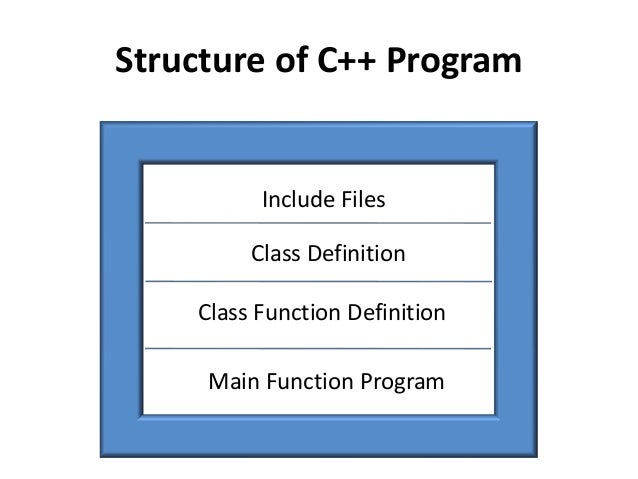This tutorial describes the program structure of the C++ program.
- Documentation
- Preprocessor Statements
- Global Declarations
- The main() function
- Local Declarations
- Program Statements & Expressions
- User Defined Functions
Let's begin with a simple C++ program code.
C++ Program which Outputs a Line of Text
Data structures A data structure is a group of data elements grouped together under one name. These data elements, known as members, can have different types and different lengths. Data structures can be declared in C using the following syntax. A C program may consist of many functions but main is mandatory. The main function is special because when OS begin executing the program, main gets called automatically. So it is necessary for you to define this function. Let us see some important Structures Programming Examples in C. Let's see the Sum of series of number program in C by using Structures with user define functions. Output 0 sum: 55 Let'. C PROGRAMMING ppt, pdf, swf & MP4 LECTURE NOTE MATERIALS FOR C SHORT COURSE with code examples. The following Table provides download materials for C short course which span for 2 weeks. In order to access the sample codes from ppt or pdf, make sure you put all the source code files under same folder as.

The above example has been used to print text on the screen.
Let's look into various parts of the above C++ program.
| /* Comments */ | Comments are a way of explaining what makes a program. The compiler ignores comments and used by others to understand the code. or This is a comment block, which is ignored by the compiler. Comment can be used anywhere in the program to add info about program or code block, which will be helpful for developers to easily understand the existing code in the future. |
| #include <iostream> | This is a preprocessor directive. It tells the preprocessor to include the contents of iostream header file in the program before compilation. This file is required for input-output statements. |
| int/void | int/void is a return value, which will be explained in a while. |
| main() | The main() is the main function where program execution begins. Every C++ program must contain only one main function. or This is a main function, which is the default entry point for every C++ program and the void in front of it indicates that it does not return a value. |
| Braces | Two curly brackets '{…}' are used to group all statements. or Curly braces which shows how much the main() function has its scope. |
std::cout<<'This is my first C++ Program';

The above line is a statement in C++. A statement must always terminate with a semicolon; otherwise, it causes a syntax error. This statement introduces two new features of C++ language, cout and << operator.
You will also notice that the words are inside inverted commas because they are what is called a string. Each letter is called a character, and a series of characters that are grouped is called a string. Strings must always be put between inverted commas.
We used std:: before cout. This is required when we use #include <iostream >.
It specifies that we are using a name cout which belongs to namespace std. A namespace is a new concept introduced by ANSI C++ which defines the scope of identifiers which are used in the program. std is the namespace where C++ standard libraries are defined.
Operator << is the insertion stream operator. It sends contents of the variable on its right to the object on its left. In our case, the right operand is the string 'This is my first c++ Program' and left operand is a cout object. So it sends the string to the cout object, and cout object then displays it on the output screen.
namespace
Structure In C++ Example
If you specify using namespace std then you don't have to put std:: throughout your code. The program will know to look in the std library to find the object. Namespace std contains all the classes, objects and functions of the standard C++ library.
Basic Structure Of C++ Program Ppt
Return Statement
| return 0 | At the end of the main function returns value 0. |
- int main() instead of void main()
- After you import your headers you required to use using namespace std;
- There is no header file like iostream.h, you only required to use this as #include <iostream>
void main() and iostream.h is only valid for Turbo C++.
